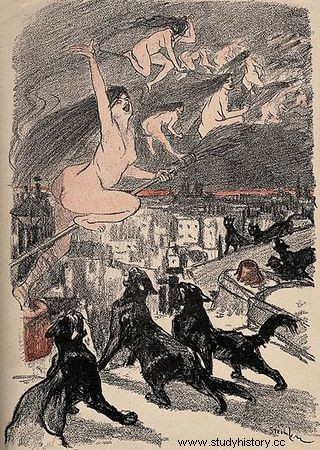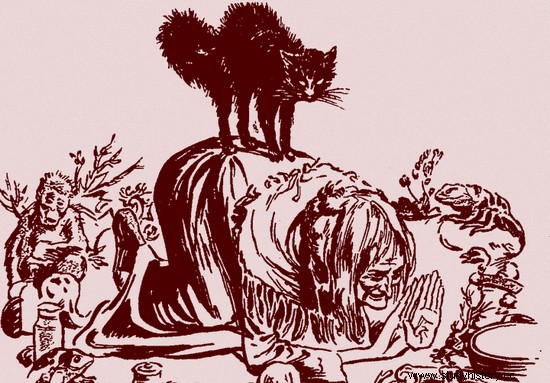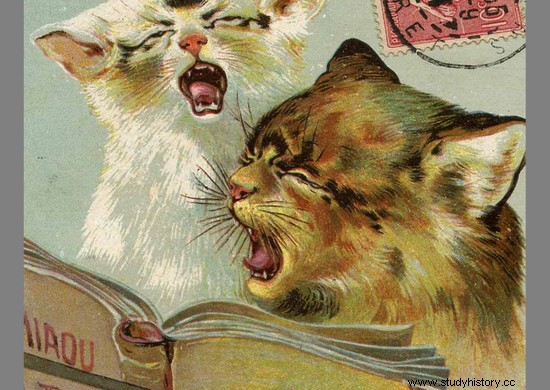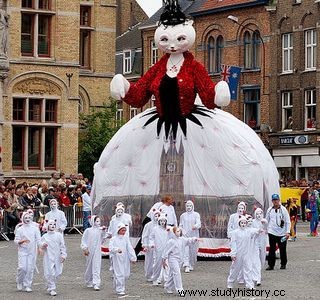They have been subjected to cruel persecution for centuries. Their bones were massively broken and their tails cut, burned alive, hung and tortured in fanciful ways. For fun, entertainment and protection against witchcraft. We present the whole truth about the feline story.
Life as a cat in the past was not easy. Not only did the dogs live in better harmony with humans, but also sheep fur coat was considered a good substitute for a rabbit. As if that were not enough, the people of the Middle Ages invented themselves that the cat is a devil or a witch in disguise. And witchcraft was serious business. Since they were enough to condemn a man to a cruel death, what about an animal?
It is no coincidence that cats were made victims of the hunt. Noiseless walking, nocturnal lifestyle, seeing in the dark, a stereotype already in the Middle Ages associating them with elderly and lonely women. To confirm the demonic nature of the animal, even ... glowing eyes were indicated. Superstitions developed in the Middle Ages in Western Europe survived until the beginning of the 19th century.

For centuries, black cats have not had it easy. They were unequivocally associated with witches, which paid for many quadrupeds with their lives. The illustration shows a 19th-century lithograph by T.A. Steinlen.
How to protect yourself from a cat?
Cats were believed to contain evil, and thus can be used as part of filthy magic rituals. In "The Story of Cats" by Madeline Swan we read, inter alia, about the Scottish witch Agnes Thompson, who in 1590 confessed to torture to cause a storm. For this purpose:
She took the cat, baptized it, and then tied the main body parts of the dead man to all members of the animal and a few of his joints. The next night, the cat was carried to the center of the sea by all the witches who could sail with a ruff or a sieve, similar to the above-mentioned one.
This is how the cat ended up near Leith, Scotland. Then the storm started so bad that it had never been worse before.
Agnes was supposed to be one of the many witches who allegedly gathered at the coven in North Berwick and decided to, among other things, sink the above-mentioned ship on which the King of Scotland, James VI Stuart and his wife, sailed. The monarch survived, but the alleged witches did not help - they were all sentenced to death.
No wonder such dangerous animals were avoided and even actively exterminated. Black cats were the main victims of persecution. As a result, this color is relatively rare today.

The witch and her black cat, which are, according to superstitions, an inseparable pair.
What is the best way to protect yourself from the charm cast by the witch in the form of a cat? Cripple him! A cat with a broken leg, tail cut off, or tanned or torn fur has been thought to lose power and cannot participate in the coven. More than one cat has had its skin skinned at night to discover bruises on the body of a woman suspected of witchcraft in the morning ...
Cat's Music - Cat's Torture
The torturing of cats was also a common pastime popular throughout modern Europe. And it must be said that our ancestors showed great ingenuity in inflicting pain on the God of the spirit of guilty furries.
The term cat's music it did not come from the noises of free-roaming people playing , but it was related to the game on the so-called cat organs. We put twenty cats, say, in wooden boxes with only their tails sticking out.
Strings were tied to these tails and pulled with special keys, which caused terrible meowing of the tortured animals. Such a "concert" was organized, for example, in Brussels in 1547 in honor of the Emperor Charles V Habsburg (1500–1558) himself. There were also times when the strings were replaced with spikes sticking into the bodies of cats.
And this is just the beginning. In Burgundy, no effort was made to construct "organs" and the cats were simply torn out by hand. This was the case in cacophonous carnival parades, which were used to ridicule betrayed husbands. Cats were unlucky enough to associate people with sex in addition to magic ...

Contrary to appearances, cat music has nothing to do with the sounds made by playing cats. The illustration shows a fragment of a 19th-century French postcard with musical cats.
Every year in Ypres, France, a fete was held, during which cats were thrown from the tower. The animals crashed against the pavement to the delight of the crowds, but the surviving ones also brought joy. It heralded a harvest.
On St. John the Baptist (June 24), the French practiced a different ritual. Hoping to ensure their success, threw into the fire anything that they thought had magical properties - mainly cats. In Saint Chamond, they chased around town after burning fur coats. In other parts of the country they were burned at stake by the dozen or tied to decorative poles and also set on fire.

The brilliant Leonardo da Vinci did not agree with the common "fashion" and was a great lover of cats. He claimed that "even the smallest cat
is a work of art." It's hard to disagree with him.
In Semur, France, on the first Sunday of Lent, children looked after cats over fires. In Aix-en-Provence, Corpus Christi was an opportunity to throw cats high enough to kill each other by hitting the ground. In Reformation London, a Protestant crowd once shaved a cat to look like a priest. The animal was then dressed in a robe pretending to be a chasuble and hanged.
Historian Robert Darnton summarized the issue briefly. "The examples could be multiplied, but the conclusion would be one:there was nothing unusual about the ritualistic killing of cats," he said.
End of persecution
Bullying of cats stopped in the 19th century. In Ypres it was not until 1817 that the throwing of cats from the tower was abandoned. As the already mentioned Madeline Swan writes:
There is now a Cat Festival in the city every three years. Instead of live animals on carnival platforms there are huge cat puppets of various shapes.
The festival depicts the symbolic burning of witches, accompanied by fireworks displays. This is a rather peculiar way of showing extreme views about the cat and commemorating a painful period of past persecution.

Today, the Ypres Cat Festival is an exhilarating celebration. However, 200 years ago, cats did not have an easy time there (photo:cirdub; lic. CC BY-SA 2.0).
It remains to be glad that cruelty towards animals, not only cats, is universally condemned today. Not so long ago it was quite the opposite…
